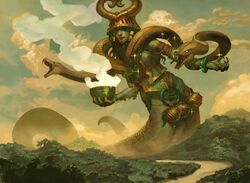Pharika
| Pharika | |
|---|---|
| God of Affliction | |
| Information | |
| Colors |
|
| Species | God |
| Birth, Life & Death | |
| Birthplace | Theros |
| Scryfall Statistics | |
|
6 artworks | |
|
16 references | |

Pharika is the God of Affliction on Theros, governing the realms of disease, poison, medicine, and the slow transformation of aging. She is strongly associated with black and green mana, embodying the balance between healing and harm. Pharika is both a healer and an alchemist, revered by those who seek cures as well as feared for the dangerous knowledge she controls. Her followers include alchemists, pharmacists, and those who respect the power of natural toxins and medicines alike. She often appears as a serpent-bodied woman and is the mother of the Gorgons, who carry potent magic within their blood.
Description
Pharika, primarily worshipped in Setessa’s Winter Nexus, is associated with affliction, grief, old age, and the secrets of alchemy. She holds knowledge of medicinal and poisonous substances and is considered the patron of apothecaries and potion-makers. Her iconic symbol is a kylix, a drinking cup from which she can produce a vast array of medicines or toxins. Though she can take various forms, she is commonly depicted as a green-skinned woman with a serpent’s lower body, bronze-scaled vipers emerging from her chest, and thickly scaled hands. Prayers to Pharika are often written on scrolls or pottery shards and deposited in bogs, reflecting the secretive nature of her worship.[1]
Pharika represents the duality of life and death condensed into a single draught: a substance that can heal or harm depending on dosage. She is the patron of those who experiment with medicines, poisons, and magical concoctions, and she views Theros as a laboratory where mortals are her agents in uncovering hidden knowledge. Her cures, while effective, frequently carry a painful or costly price, demanding sacrifice either in suffering or years of life. Pharika’s influence extends to the natural cycles of aging and the petrification associated with her medusa children.
Divine Relationships
Pharika has generally cordial relationships with many gods, often providing cures or essential tonics in times of need. She maintains a respectful but complex connection with the gods of the Underworld, especially Athreos and Erebos, appreciating the latter’s realm though resenting mortals who appeal to Erebos instead of seeking her healing or peaceful death. Among the gods of civilization, she is cautiously tolerated by Ephara and Karametra, who recognize her medicinal value but seek to tame the world in ways she disdains. Pharika especially values the mysteries represented by gods of knowledge like Kruphix, while despising Keranos for bestowing wisdom on those she deems unworthy. Her closest and most cherished relationship is with Nylea, whose natural bounty she reveres and whose defense she fiercely supports.
Worship
Pharika’s worshipers often include the diseased, the dying, alchemists, and those who work with potions and poisons. Devotees write prayers on scraps of paper or pottery and bury them in bogs, creating secret caches for future discovery. She is prayed to before medical treatments, herbal harvests, or encounters with venomous creatures. Nights of the waxing crescent moon are sacred for gathering medicinal plants in her honor. Mystery cults dedicated to her explore different aspects of her nature, the most infamous being the Cult of Frozen Faith, whose initiates undergo a dangerous transformation involving petrification and resurrection, surviving only if Pharika favors them.
History
Like other gods of Theros, Pharika was affected by the Silence of the Gods, during which she was unable to influence mortal diseases or healing.[1] She is known for having seeded Theros with secret truths about medicine, minerals, and magic hidden throughout the wilds and Underworld, leaving clues for mortals to discover and experiment with. Pharika’s studies of mortal suffering and innovation drive her ongoing interest in mortal affairs, often pushing followers to become subjects in her divine experiments.[1]
Inspiration
The character of Pharika is inspired by aspects of several Greek gods, including Hecate, goddess of witchcraft, herbs, and poisonous plants, Circe, goddess of magic and plants, or Asclepius and his son Telesphorus who dealt with medicine and recuperation from illness (the snake is the sacred symbol of Asclepius).
Pharika is also remarkably similar to the Egyptian god Serket, which also represents the dichotomy of poison and cure. She may also be based on Panacea, goddess of salves, droughts, and medicine, and Angitia, a Roman snake goddess of healing, and the Gorgons.
Pharika's name may have been partly taken from the Ancient Greek word φάρμακον (phármakon), which could refer to a curative drug or a poison and is the root of the English word 'pharmacy'.
Story appearances
Gallery
In-game references
- Represented in:
- Associated cards:
- Depicted in:
- Quoted or referred to:
External links
- The Magic Creative Team (September 04, 2013). "Planeswalker Guide to Theros, Part 3". magicthegathering.com. Wizards of the Coast.
- Jenna Helland (September 11, 2013). "The Lost Confession". magicthegathering.com. Wizards of the Coast. Archived from the original on 2019-12-24.
- The Magic Creative Team (April 02, 2014). "Planeswalker's Guide to Journey into Nyx". magicthegathering.com. Wizards of the Coast. Archived from the original on 2020-11-12.
References
- ↑ a b c Jenna Helland (April 2014). "Theros: Godsend, Part I." Wizards of the Coast. ISBN 978-0-7869-6556-4.

